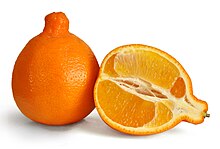Tangelo
| Tangelo | |
|---|---|
 |
|
| A tangelo fruit (Cushman Honeybells) | |
| Scientific classification | |
| Kingdom: | Plantae |
| (unranked): | Angiosperms |
| (unranked): | Eudicots |
| (unranked): | Rosids |
| Order: | Sapindales |
| Family: | Rutaceae |
| Genus: | Citrus |
| Species: | C. × tangelo |
| Binomial name | |
|
Citrus × tangelo J.W. Ingram & H.E. Moore, 1975 |
|
The tangelo (/ˈtændʒəloʊ/ TAN-jə-loh or /tænˈdʒɛloʊ/ tan-JEL-loh; C. reticulata × C. maxima or x C. paradisi), Citrus × tangelo, is a citrus fruit hybrid of tangerine and pomelo or grapefruit.
Sometimes referred to as honeybells, tangelos are the size of an adult fist, have a tangerine taste, and are juicy at the expense of flesh. They generally have loose skin and are easier to peel than oranges, readily distinguished from them by a characteristic "nipple" at the stem. Tangelos can be used as a substitute for mandarin oranges or sweet oranges.
The early maturing Orlando tangelo is noted for its juiciness, mild and sweet flavour, large size, and flat-round shape with a characteristic knob. California/Arizona tangelos have a slightly pebbled texture, good interior and exterior colour, very few seeds, and a tight-fitting rind. Orlando tangelos are available from mid-November to the beginning of February. It originated as a cross between a Duncan grapefruit and a Dancy tangerine.W. T. Swingle of the United States Department of Agriculture (USDA) is credited with creating the hybrid in 1911. When the Orlando tangelo was first cultivated, it was known by the name Lake tangelo. The trees of this variety grow to a large size and are easily recognised by their cup-shape leaves. Orlando tangelos are recognised as one of the more cold-tolerant varieties. Northern Florida grows significantly fewer tangelos, but they are much sweeter due to climate.
...
Wikipedia
